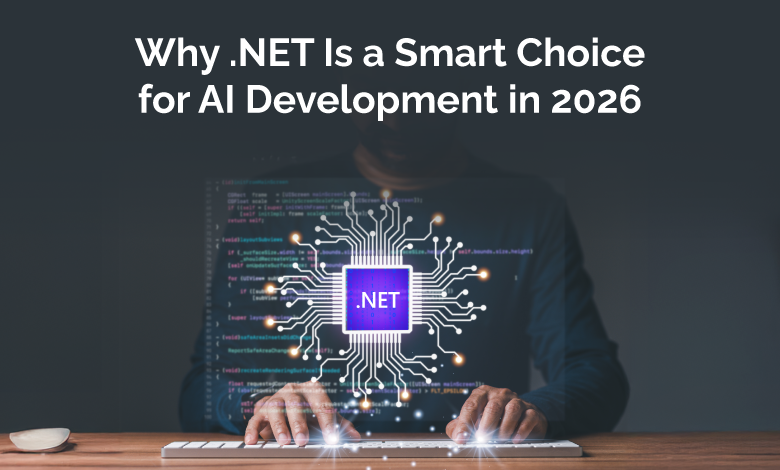
AI is no longer an experiment – it’s real, it’s here, and it’s transforming business operations in ways we never imagined. As a CTO, you’re faced with the challenge of creating intelligent systems that are not only fast and scalable but also secure.
This is where .NET stands out. It’s no longer just a legacy tool but a powerful, future-ready platform for building AI-driven solutions. With its smooth integration into advanced frameworks like ML.NET, ONNX Runtime, and Azure AI, .NET allows you to efficiently build, train, and deploy AI models.
Organizations are actively hiring skilled .NET developers to unlock the platform’s full potential. That’s because .NET offers the best of both worlds: reliable enterprise-grade infrastructure paired with the latest AI capabilities. It supports everything from cross-platform workloads to cloud-native deployments and even edge AI—all within a unified environment.
Enterprise AI Development with .NET: Top Reasons to Consider
The benefits of selecting .NET for AI development are listed below:
1. The Evolving .NET Ecosystem for AI
If you’ve been following .NET’s journey, you’ve seen how far it has come. It emerged from a Windows-centric framework to a unified, cloud-ready, and AI-capable platform.
With the latest versions, .NET now offers seamless support for AI workloads. You can train, deploy, and serve models within your existing .NET infrastructure. There’s no need to switch languages or platforms. The unified runtime enables you to build AI applications that run efficiently on Windows, Linux, macOS, or even mobile through .NET MAUI.
2. Interoperability: AI Anywhere, Seamlessly
In 2026, your AI strategy can’t afford to live in silos. You need systems that talk to each other – across platforms, tools, and environments.
You can easily connect .NET with popular AI ecosystems like Python, TensorFlow, and PyTorch through supported bindings and APIs. Your data science teams can continue building models in Python while your engineering teams integrate and deploy them in .NET with minimal friction. With ONNX Runtime, you can take pre-trained models from any framework and run them inside your .NET applications.
This flexibility reduces dependency on a single tech stack and simplifies your AI deployment pipeline. You can scale faster, leverage existing infrastructure, and maintain consistent performance across environments.
3. ML.NET: Democratizing Machine Learning for Enterprises
ML.NET brings machine learning capabilities into the .NET environment. You don’t need to hire a new team of data scientists to get started. Your existing C# developers can build, train, and deploy models within familiar tools like Visual Studio.
ML.NET simplifies complex ML workflows with built-in features for classification, regression, forecasting, and anomaly detection. It even supports AutoML, which automatically selects and tunes the best model for your data. And when you’re ready to scale, you can integrate with ONNX Runtime to deploy models trained in Python or TensorFlow without rewriting code.
4. Enterprise-Grade Security and Governance
AI systems are only as strong as the security behind them. By choosing .NET, you get an ecosystem that prioritizes security under all circumstances. Built and maintained by Microsoft, .NET benefits from the same security standards that power Azure.
You can integrate .NET applications with Azure Active Directory, Key Vault, and Role-Based Access Controls (RBAC). Here, the objective is to protect sensitive data and manage access at a granular level. Your AI models, APIs, and data pipelines stay under tight governance, no matter how complex your architecture becomes.
Compliance is another area where .NET stands tall. Its alignment with standards like SOC 2, ISO 27001, GDPR, and HIPAA helps you meet audit requirements without additional overhead. For industries handling regulated data, this level of assurance is crucial.
5. Performance and Scalability: Built for Enterprise AI
When you’re building enterprise-grade AI systems, performance is a mandate. Every millisecond matters in model inference and user response. Hence, you need a framework that can keep pace.
The latest versions of .NET bring significant runtime enhancements through Just-In-Time (JIT) and Ahead-Of-Time (AOT) compilation. As a result, your AI applications run faster and consume fewer resources. You can now handle complex computations, parallel tasks, and large-scale data processing.
.NET also integrates seamlessly with GPU-accelerated environments and supports async I/O. This enables real-time predictions and faster inferencing. Whether you’re deploying models for fraud detection or recommendation engines, you can achieve low-latency responses even under heavy traffic.
For scalability, .NET plays well with microservices and Kubernetes. You can scale workloads horizontally across multiple instances. This ensures your AI systems remain responsive as demand grows.
6. Cloud-Native and Edge AI Deployment with .NET
Just thinking about building AI models won’t be enough. You have to think about where and how they’ll run. .NET is built for cloud-native environments. You can deploy AI workloads seamlessly across Azure, AWS, or hybrid clouds. With Azure AI, Cognitive Services, and Azure Kubernetes Service (AKS), you can scale models effortlessly, automate deployments, and ensure consistent performance even if there’s heavy demand.
.NET also extends its strength to the edge. Using tools like .NET IoT and nanoFramework, you can bring AI inference closer to the data source. This reduces latency, boosts security, and enables real-time decision-making.
7. Total Cost of Ownership (TCO) and Resource Efficiency
When you evaluate frameworks for long-term AI strategy, cost efficiency often decides the winner. With .NET, you don’t need to build or maintain multiple tech stacks. Your existing C# developers can contribute to AI projects using familiar tools like Visual Studio, ML.NET, and Azure AI. This lowers the need for niche skill sets and reduces onboarding costs. The unified ecosystem also minimizes integration overhead.
From a DevOps standpoint, .NET’s compatibility with containers, Kubernetes, and cloud-native environments cuts deployment friction and improves resource utilization. Its runtime optimizations and native cloud scaling help you run workloads faster, with less compute expense.
Over a 3-5 year horizon, these efficiencies add up – fewer tools to maintain, fewer specialists to hire, and better use of existing infrastructure.
The Future Roadmap: .NET and Generative AI
The future belongs to systems that can think, learn, and respond intelligently. So, integrating AI into .NET applications is absolutely necessary. Microsoft is already steering .NET toward that future by embedding Generative AI capabilities within its ecosystem. Here’s how .NET is evolving to support that future:
- Native Generative AI Support: Upcoming .NET releases are integrating directly with OpenAI and Azure OpenAI APIs. You can embed text, vision, and speech intelligence into your products without a complex setup.
- Semantic Kernel Integration: Microsoft’s Semantic Kernel enables you to create AI agents that reason, plan, and act. It connects .NET applications with LLMs, memory stores, and vector databases.
- Copilot-Driven Development: With Visual Studio and GitHub Copilot, your development teams can write smarter code, automate repetitive tasks, and reduce cycle times.
- Future-Ready APIs: New .NET libraries are designed for conversational interfaces, prompt orchestration, and fine-tuned LLM workflows. This makes it easier to operationalize Generative AI at scale.
Challenges and Considerations
Even with its strengths, .NET isn’t a one-size-fits-all solution for every AI initiative. Before fully committing to .NET for AI development, it’s worth considering a few practical challenges and trade-offs:
- Limited for Deep Research Workflows: If your team focuses on experimental AI or advanced data science, Python is still the winner. It offers more mature libraries and community-driven research tools. .NET works best for productionizing models, not exploratory analysis.
- Dependence on the Microsoft Ecosystem: Tight Azure integration is definitely a strength, but it can also lead to partial vendor lock-in. To maintain flexibility, design your architecture around open standards like ONNX and containerized deployments.
- Talent Availability: Skilled .NET AI developers are growing, but still fewer compared to Python experts. You may need internal training or hybrid teams to fill that gap.
- Ecosystem Maturity in Some AI Areas: ML.NET is evolving rapidly, yet some niche AI capabilities (like reinforcement learning or generative frameworks) may lag behind specialized libraries.
Conclusion
.NET is a good choice in 2026 because it gives you the balance every enterprise needs: modern performance, top-notch security, and seamless integration with today’s leading AI tools. Without managing fragmented tech stacks, you can unify development, deployment, and AI operations. This helps your teams stay productive and keeps your infrastructure optimized. Also, you can scale AI projects with confidence.




